The |
 |
The |
 |
What's a ranch without animals? Not much of a ranch, that's for sure!
Most of the animals at Liberty Haven Ranch don't exactly "belong" to us, but they live here and so we've adopted them. Of course, there are hundreds of lizards and dozens of rabbits here, but we also have some larger and more distinctive residents. Here are a few of the "regulars" at our ranch.
 Heidi is a first-generation Golden Retriever / Yellow Lab mix. She was born in October of 2004. We acquired her as a companion for our first mixed retriever, Fergus, shortly after losing his original mate, Tracey. We named her Heidi because of her fondness for hiding under desk kneeholes, behind furniture, and under beds when she was a puppy. She weighs about 75 pounds, and is much lighter in color than our other dogs, being closer to Yellow Lab color.
Heidi is a first-generation Golden Retriever / Yellow Lab mix. She was born in October of 2004. We acquired her as a companion for our first mixed retriever, Fergus, shortly after losing his original mate, Tracey. We named her Heidi because of her fondness for hiding under desk kneeholes, behind furniture, and under beds when she was a puppy. She weighs about 75 pounds, and is much lighter in color than our other dogs, being closer to Yellow Lab color.Heidi is a strong and enthusiastic swimmer, and our most "take charge" dog. She loves to chase flying animals, including dragonflies and moths, and she will leap headlong into the pool if she thinks she can catch one that way. She is an extremely dutiful and attentive mother, and her litters are on the large side. She is very much "Dad's dog," piling up against him on the couch during TV time. She is afraid of very little, and loves dunking the other dogs in the pool. Some of her puppies have become hunting partners and assistance dogs.

Born in July of 2004, she is a young registered Golden Retriever. She is very good-natured and gentle, and loves to play "eat your face" for hours with her "little sister" Heidi. Just as Heidi likes to chase flying critters, Honey likes to chase and catch ground game like rabbits, lizards, and pack rats. Honey is also a prolific digger of holes, almost always in pursuit of critters.
Honey is a certified Therapy Dog, trained and eligible to visit hospitals and nursing homes. She considers herself the alpha female of our pack, and tirelessly plays chaperone whenever any of the males show any interest in the other girls. She has the most soulful eyes and the softest and fluffiest fur of all our dogs.
Cinnamon
We acquired Cinnamon just after New Year's, 2002. Cinnamon is a 21-year-old, 1,400-pound Belgian draft horse/quarterhorse mix -- a hefty mount for a hefty rider. He requires about twice the rations that Wrigley does. He rides and packs, and has been trained to guest ranch duty and hunting. He was partially trained to drive, but his previous owner could never find a match to make a team.
Cinnamon has the classic draft horse neck and head, but his legs, while stocky, are more quarterhorse-length. Still, he stands 16.2 hands high, and just fits in our trailer -- in all three dimensions!
It's sometimes impossible to get tack for Cinnamon "off the rack" at the local tack stores, but his owner has been used to shopping the same way for most of his life. Luckily for Cinnamon, at least his shoes -- while huge -- are available off the rack.
Cinnamon generally has a very quiet and laid-back disposition with people, and enjoys attention. Cinnamon and Burrito are best buddies.
Cinnamon appreciates all his treats -- sugar cubes, jellybeans, mints, carrots, apples, corncobs, and corn husks. He's the only animal we have who actually enjoys eating lemons and lemon rinds. (Between the livestock, the dogs, and our chickens, there are very few organic leftovers that ever go to waste on this ranch.)
Burrito
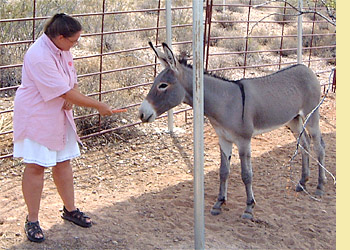 Burrito wandered inside our compound fence in August 2001, during a night when our automatic gate was stuck open. At first, we reported him as an escapee from a nearby ranch, because there wasn't a scar or a mark on him and he looked beautifully kept. Later, we learned he was a young wild burro of about eight months, so we formally adopted him from the federal Bureau of Land Management, which legally "owns" all wild burros.
Burrito wandered inside our compound fence in August 2001, during a night when our automatic gate was stuck open. At first, we reported him as an escapee from a nearby ranch, because there wasn't a scar or a mark on him and he looked beautifully kept. Later, we learned he was a young wild burro of about eight months, so we formally adopted him from the federal Bureau of Land Management, which legally "owns" all wild burros.
Burrito learned to trust people inside a week. At first he didn't get along well with our dogs, because he grew up around coyotes in the wild and Fergus chased him on the first day. Fergus learned better when Burrito aimed a few kicks his way. Now our dogs and Burrito understand each other well, and they even occasionally play with each other. Burrito also enjoys taking a rope or other swinging toy in his mouth, whirling it around, and chasing his buddies around the corral with it.
Burrito is very curious and approaches people just to get petted. He has learned how to "pony along" with a group of riders, either on a lead rope or using no rope at all.

Burrito usually eats hay, but what he really likes is to munch on our lawn. We let him out on "weed patrol" because (unlike our horses) he has no taste for our roses and other flowers. He's very adventurous about new foods and treats. Being from the wild, where food is scarce, he'll try anything once just to check it out. We'll give him a carrot or an apple for a treat, or sometimes a sugar cube, a marshmallow, or even a jellybean. But his favorite treat of all is a Starlight Mint.
Dunbar
Dunbar is a young Arab-type grade horse born in 1999 who joined our Ranch family in January of 2005. He is gentle and responsive, and loves treats. He has the tough Arab hoof that doesn't require shoeing for trail rides, and he is extremely sure-footed even on steep hillsides.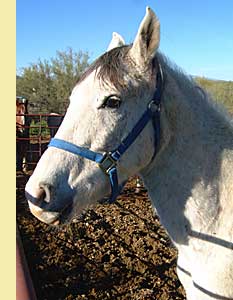
Dunbar is our shyest horse, but he is very affectionate and loves to be brushed or to have his neck rubbed. He got his name from a grayish-brown bar marking on his forehead.
As the youngest and smallest horse, Dunbar is at the bottom of the corral pecking order. He spends a lot of his time palling around with Burrito. (Burrito gets along with everybody!)
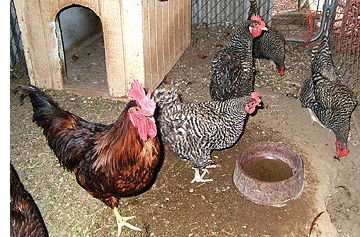
The Stewdebakers provide the Ranch with farm-fresh eggs daily. A diverse collection, they include Barred Rocks, Rhode Island Reds, and even a Silkie (a chicken that resembles a miniature emu). They live in a shaded, steel-sheltered wire coop just outside the barn. A water mister keeps the birds cool and healthy through our triple-digit summer temperatures.
Chicken Stu is a Rhode Island Red rooster, who keeps the ladies happy and orderly. He also provides occasional clutches of new chicks to replace hens lost to accident, predation, or the Weber. He and the girls put on a rousing matinee performance at the Bunkhouse seven days a week. Catch Stu if you can -- he'll be here all year (if he behaves).
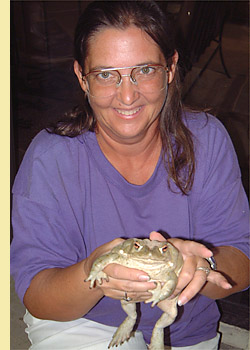
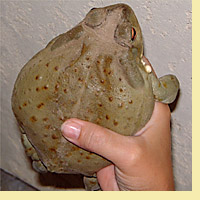 Freddie comes out at night, and we can usually find him at our rear sliders. All the bugs in the neighborhood are attracted to the sliders because of the lights inside the house, and that's just like serving a toad buffet. When things are quiet at night, we can often hear the "bump... bump" of Freddie snarfing bugs off the glass.
Freddie comes out at night, and we can usually find him at our rear sliders. All the bugs in the neighborhood are attracted to the sliders because of the lights inside the house, and that's just like serving a toad buffet. When things are quiet at night, we can often hear the "bump... bump" of Freddie snarfing bugs off the glass.
We have at least three Colorado River Toads in the compound, one of them (probably a young one) about half the size of the others. To keep them all straight, we call them all Freddie.
Colorado River Toads are the famous "psychedelic toads." They are the only toad with a hallucinogenic venom (on their skin -- they don't bite). Some people dry it and smoke it. I just say no to smoking toad (and it wasn't exactly a tough decision).
Although it's perfectly safe for people to pick Freddie up with their hands (as long as they wash their hands before eating or picking their noses), the venom can kill other animals who pick up these toads in their mouths. We had to teach our retrievers that Freddie was "not for dogs," and now they leave Freddie alone. In this region, dogs that pick up these toads get dumped right in the swimming pool or bathtub, and get their mouths sprayed out for as long as they will stand for it.
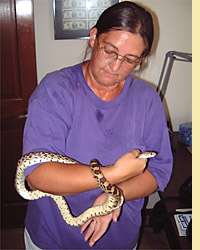 Although Gomer is about the same color as a rattlesnake, he isn't one. Gomer is a gopher snake. He has no rattles or venom, though he can and will hiss, strike, and bite when he's unhappy.
Although Gomer is about the same color as a rattlesnake, he isn't one. Gomer is a gopher snake. He has no rattles or venom, though he can and will hiss, strike, and bite when he's unhappy.Gomer lives on rodents. There are enough pack rats and burrowing ground squirrels out here to be a bother, so Gomer is really a good critter to keep around.
Do we have rattlesnakes in our area? Yes, and you can see them further down on this page. We certainly don't handle them the same way we would handle Gomer!

We have a number of these on the ranch, but they usually keep themselves well-hidden in places like irrigation holes, crawlspaces, and drainpipes. We come across about one per month. This one had crawled up behind the screens on our slider at night to catch some tasty bugs. Tarantulas don't spin webs, but they do wrap caught bugs in silk.
This one is small to medium-sized for a tarantula. Out on the airstrip, we encountered one about five inches long, toe-tip to toe-tip.
Tarantulas are harmless to humans. They will rarely bite, which is no worse than a bee sting, and their venom is not poisonous to people or pets. The folks at the American Tarantula Society say they can even be trained as pets, although none of us here have any plans to do that.
 Arizona has zillions of hummingbirds. Attracting them is quite easy: get a bright-colored hummingbird feeder and keep it regularly filled with hummingbird food, which is a special sugar-water solution. You have to change it regularly, because otherwise it will ferment and the birds will go elsewhere. We keep our feeder out by the pool, where you can watch the hummers flit in and out and chase each other away with loud chirps and buzzes.
Arizona has zillions of hummingbirds. Attracting them is quite easy: get a bright-colored hummingbird feeder and keep it regularly filled with hummingbird food, which is a special sugar-water solution. You have to change it regularly, because otherwise it will ferment and the birds will go elsewhere. We keep our feeder out by the pool, where you can watch the hummers flit in and out and chase each other away with loud chirps and buzzes.This little lady is a Rufous Hummingbird. We know we have at least three Rufous Hummingbirds, because we've seen them all together at the same time. They are very territorial, and the biggest one will usually chase all the others away from the feeder with loud chirps. Of course, since it doesn't stay at the feeder very long, they all eventually get turns and nobody goes hungry.
We also see a good number of Black-chinned Hummingbirds and Broad-tailed
Hummingbirds on the ranch. You can tell when a Broad-tailed Hummingbird is around, because his wings sound like a cricket or an air compressor that needs oil.
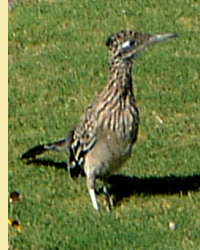
Road runners are not very colorful birds. When they're not running across the desert faster than jackrabbits, they might stand in one spot for a good long while, doing nothing but raising and lowering their tails. If you took a peacock and stripped off all the chrome and sheet metal so you could enter it in a drag race, what you'd have left would be a road runner.
Although they resemble chickens somewhat, road runners belong to the cuckoo family. They are very handy to have around because they kill and eat rattlesnakes. Unfortunately, they also snatch baby quail as they follow in line behind their parents.
Road runners don't say "meep meep," and coyotes don't like to eat them because they don't really taste that good.
 We don't see many of these fellows. They like to stay hidden. The only way you will see them is if you disturb them where they are hiding, like under old lumber or rock piles, or in irrigation access pits.
We don't see many of these fellows. They like to stay hidden. The only way you will see them is if you disturb them where they are hiding, like under old lumber or rock piles, or in irrigation access pits.
This is a Giant Desert Hairy Scorpion, the largest scorpion in North America. Although he will sting you aggressively, his poison is generally not harmful to humans. This scorpion was found drowned in a water trough. He was ivory white when he was found, but he returned to this normal color when he dried out.

Occasionally, we patrol the property and clean some of the cottontails out, or they would destroy our vegetables. Often, even when a rabbit is hit well, it will hop away and hide before it dies. Our dogs enjoy pursuing and retrieving those bunnies very much, and when they act together as a pack, they are very good at it.
Cottontails are so abundant in Arizona that the "bag limit" you can take is ten rabbits each and every day. But desert cottontails are often so scrawny that cooking them isn't worth all the effort, and many of them are less than healthy. The vultures, coyotes, and owls appreciate the windfall.
 The Velvet Ant is actually not an ant at all -- it is a female wasp. The females have no wings, but a powerful stinger. The males have wings and fly, but have no stinger at all.
The Velvet Ant is actually not an ant at all -- it is a female wasp. The females have no wings, but a powerful stinger. The males have wings and fly, but have no stinger at all.Being a wasp, the Velvet Ant can sting you multiple times without dying. The wasp's sting is reported to be so painful that it is also known as the "Cowkiller Wasp." Our boy didn't know how brave he was being when he bottled up this critter!
This bug is armored like a tank. She wanders around the ground, looking for the nests of other wasps or bees. When she finds one, she barges her way in and lays her eggs there. The owner often tries to sting her, but can't get through her armor. I have seen Velvet Ants walk away from deliberate, repeated boot stompings.

This is the same vulture you have seen drawn for decades in desert cartoons: huge and black, with a cadaverous-looking red head. It feeds almost entirely on dead animals, although it will occasionally eat small, live ones. It has an acute sense of smell and keen eyesight.
No matter how spoiled the food they find to eat, Turkey Vultures never suffer from food poisoning because their digestive system is able to kill 100% of the bacteria and viruses found in their food.
The Turkey Vulture and the threatened California Condor (also a vulture) are closely related. These birds belong to the same family as storks and flamingos.
Scavengers play an important role here at the ranch, where dead animals are not exactly rare -- whether they are rabbits we have dispatched, or coyotes hit on the highway. If we deposit these remains in the desert well away from the house, we invariably find them picked down to bones and fur the very next day by the cooperation of vultures, coyotes, owls, and rodents. In a week, even the insides have been polished clean by insects. Believe me, the desert smells much better as a result.
 This is the one and only Banded Sand Snake that we've seen. These snakes are active mostly at night, which is one reason why. This poor fellow ended up drowned in a water trough, or we never would have seen him.
This is the one and only Banded Sand Snake that we've seen. These snakes are active mostly at night, which is one reason why. This poor fellow ended up drowned in a water trough, or we never would have seen him.The Banded Sand Snake is non-poisonous. His shovel-shaped snout and streamlined head allow him to literally swim through fine sand. Our ranch is reportedly at the northernmost end of his habitat, which is limited to southwestern Arizona and a small adjacent part of Mexico.
Banded Sand Snakes don't get much larger than this -- about the size of a fresh pencil. This one is fully adult.
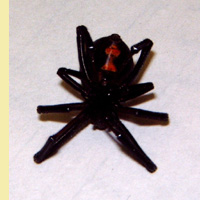
The female Black Widow is the most venomous spider in North America, with venom 15 times more toxic than a rattlesnake. Luckily, they are so much smaller than adult humans that their bite is rarely deadly -- but it can cause muscle spasms and breathing difficulties.
This photo is of the underside of the spider, where you can see the distinctive red "hourglass." In the wild, the hourglass is usually easy to see because these spiders hang upside-down on their webs and rarely leave them.
This little lady was hiding inside an electric outlet box out by the windmill. I found her while installing a timer for our Christmas lights. She was pretty lively in her jar until about three hours before we took her photo, when we put her in the freezer for 20 minutes to knock her out long enough to photograph her. Well, we forgot her, which is why her legs are all folded up.

The diamondback is named for the obvious pattern on his back. He is one of only two rattlers to have "raccoon stripes" near his tail, the other being the Red Diamondback.
Every year, a rattler sheds his skin. Every shed adds one "knob" to the rattle. The specimen on the right is ten or eleven years old. Both these snakes are between three and four feet long.
Outside the residential compound, rattlers are quite common (and occasionally inside, too, since they're good at finding new weaknesses in fences). When we come across a snake inside the fenced residential area, we grab it with a snake stick, bag it, and pop it into the freezer. This is a very humane death for a cold-blooded animal and preserves the skins. (Yes, the snakes in the photo are snake-sicles.) The ones outside the fence we leave alone, because they eat packrats, moles, and other pesky rodents. But you want to think twice before walking outside of the fenced yard wearing a Walkman, shooting muffs, or a metal detector headset.
Snake hunting is legal in Arizona with a basic hunting license. Snakes are one of the few species that is legal to hunt at night with lights. Larger snake skins bring a good price, but many hunters sell snakes live to labs, where they milk their poison venom to make antidotes and other pharmaceuticals. We trade our frozen captures to a local artisan for snakeskin crafts.
All our adult dogs have been to see the snake-breaker at least twice. This lady puts a shock collar on your dog and then sets out a live, de-fanged rattlesnake. When your dog approaches it, she gives him a shock. After a couple shocks, your dog will not approach a snake again. It's vital training for dogs in rural Arizona.
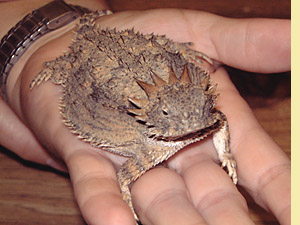 This handsome fellow was Tracey's first catch, and the first Regal Horned Lizard we've seen. Check out his impressive crown -- just like a miniature dinosaur.
This handsome fellow was Tracey's first catch, and the first Regal Horned Lizard we've seen. Check out his impressive crown -- just like a miniature dinosaur.Regal Horned Lizards live only in southern Arizona. Their habitat swings east of Phoenix, but once north of the city it shoots abruptly west and ends in the Wickenburg area.
Regal Horned Lizards are out and about mostly in the dawn hours, with a brief burst of activity around sunset (which is when he was corralled). He has a smooth, leathery, white belly, and a habit of going stiff and belly-up when he thinks he's in danger. Some of the better actors of this species will even squirt a little blood out of their eye.
But this fellow was really docile about being handled, and was rewarded with a comfortable nook in our garden after the studio session.
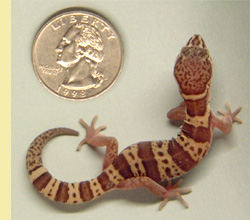
When we came across him recently, he had a cricket hanging out of his face that was bigger than his head. We have no idea how he managed to eat it.
When captured, or when defending his turf, this fellow chirps like a bird. He's very welcome in our barn because he keeps insects down, especially spiders, crickets, and roly-polys. Unfortunately, snakes find him very tasty in turn.
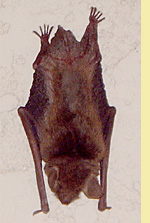 After a long wait, we were lucky to catch a photo of this cuddly little fellow hanging on a shady stucco wall at a time of day when his tribe is not usually out and about. He is one of a friendly flock of Mexican Brown Bats who live somewhere in the desert around the Ranch.
After a long wait, we were lucky to catch a photo of this cuddly little fellow hanging on a shady stucco wall at a time of day when his tribe is not usually out and about. He is one of a friendly flock of Mexican Brown Bats who live somewhere in the desert around the Ranch.We see these fellows in singles and pairs around dusk and dawn. During the warm months, they visit the Ranch nightly because we are the only source of open water in the area. When we are cooling off in the pool at sundown after a hard day of work, it's common for us to see a little flitter out of the corner of an eye, followed by a light "slap" on the surface of the water as a bat takes a drink. In return, these bats help keep our pool area free of flying insects. In the winter, the bats migrate south.
Mexican Brown Bats take up residence in cavities inside saguaro cactuses -- usually holes drilled out by the Gila Woodpecker and then abandoned. As folks who appreciate bats, we constructed a bat house for the little fellows, but hadn't planned on having to erect the extra thirty-foot pole we would need to mount it in the desert. (It's not like we can nail it to a saguaro, and the desert is not known for its tall trees!)
A naturalist friend of ours informs us that "Mexican Brown Bat" is only a generic, popular name. "He is a Myotis species ('little or small brown bat'). But which one of the nine Myotis species in Arizona he belongs to, I can't tell from the photograph. The best I could do would be to narrow it down to three or four species based upon ear length and color, the bit of fur on its nose, and its geographic location. I imagine there are actually quite a few bat species on your ranch. 28 species exist in Arizona, the most of any state, and several are common to your area. The little guy you photographed screwed up and stayed out too late eating, so he had to find temporary lodging at your patio rather than return to the roost."

King Snakes can be found all across America -- up and down each coast and across the southern sections of the US. They come in a wide assortment of colors, from black and white to brown and yellow, sometimes with red bands. They will bite if they are apprehensive, but the bite is non-poisonous, like their close relatives the Gopher Snakes.
They capture their food by coiling around it, then search around their victim until they locate the head, which goes down the gullet first. The entire process takes only about three minutes.
Their strong constrictor muscles allow them to rise to an extreme vertical position, and even give them the strength to lever covers off "temporary accommodations" (yup, we learned this the hard way).
A King Snake about half this fellow's size goes for around $75 from area vendors.
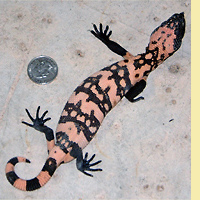 This pretty young pink-and-black specimen got pinned trying to wedge itself under the critter fencing at our entry gate. Tracey called our attention to it, but didn't touch it. We freed it up carefully and brought it to the back porch for photos. We've seen a number of Gila monsters in the wild in desert areas around Wickenburg and Congress, but this was our first at the Ranch. (Since we took this photo, we have discovered Gila Monsters inside our residential fence roughly every other year.)
This pretty young pink-and-black specimen got pinned trying to wedge itself under the critter fencing at our entry gate. Tracey called our attention to it, but didn't touch it. We freed it up carefully and brought it to the back porch for photos. We've seen a number of Gila monsters in the wild in desert areas around Wickenburg and Congress, but this was our first at the Ranch. (Since we took this photo, we have discovered Gila Monsters inside our residential fence roughly every other year.)This is a small specimen -- the quarter gives you an idea of its size. Fully grown Gila monsters run 18 to 24 inches. Gila monsters -- a protected species in Arizona -- are one of only two venomous lizards in existence, though their poison is rarely fatal to humans. Unlike snakes, they don't inject poison -- they just bite you and chew, and slobber venom while they're doing it.
We let this one loose out in back of the corral, whereupon it immediately ran under the horse trough. They love adopting ready-made burrows, and we know there are lots of tasty bugs under the trough to keep it happy.
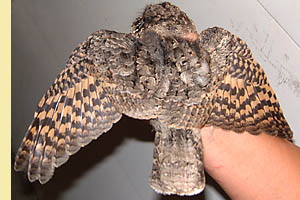
The Common Poorwill is actually a small hawk -- the smallest Nightjar species. At dusk during the warmer months, he and several of his fellows are nightly visitors to our swimming pool. They drink from it on the wing, flying slow and low over the surface while they drop their lower beaks like little scoops. It's very enjoyable to watch, and they are just as happy to take their drink when people are present in the pool.
The Poorwill only says "poor-will" during breeding season. On the wing approaching our pool, they call out with a pleasant "wurt, wurt, wurt!"
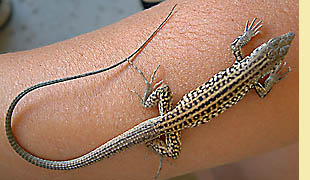 There are many species of Whiptail Lizard, and they all look pretty similar in the critter guide. We believe this one is a Western Whiptail, which lives all over the western US and Mexico as far north as Idaho.
There are many species of Whiptail Lizard, and they all look pretty similar in the critter guide. We believe this one is a Western Whiptail, which lives all over the western US and Mexico as far north as Idaho.These lizards are burrowers and runners, and like to live in sparsely vegetated areas where they can run from pursuers. They stalk and eat anything small that moves, including scorpions and spiders. As you can see, the tail on this little lady is longer than the rest of her body.
We see Whiptails all the time on the Ranch. We fished this one out of the pool and set her back in the shrubbery when we were done. She was very docile.
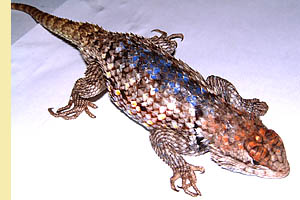
Desert Spiny Lizards are quite common on the Ranch. They are active during the day, and climb walls and trees in search of insects. We found this fellow tangled up in our fruit tree netting, and he was quite content to let us handle and take a few photos of him before he got back to his business.
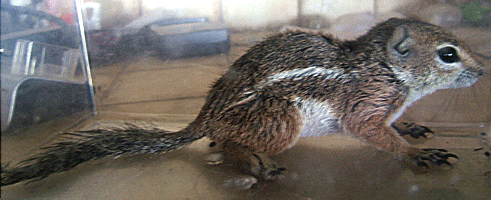 Honey fetched us this Harris's Antelope Squirrel one day. (She brought it back in perfect health, but you can see that its tail is not quite dry of dog slobber.) We see several of these little creatures practically every day, usually hopping across roads or driveways, but they are generally too quick and evasive to approach or photograph well. We also see dozens of the inch-wide burrows they dig all over the desert.
Honey fetched us this Harris's Antelope Squirrel one day. (She brought it back in perfect health, but you can see that its tail is not quite dry of dog slobber.) We see several of these little creatures practically every day, usually hopping across roads or driveways, but they are generally too quick and evasive to approach or photograph well. We also see dozens of the inch-wide burrows they dig all over the desert.While the Antelope Squirrel is a warm-blooded mammal, it is specially adapted to our desert environment. It's very heat-tolerant, and can attain body temperatures over 103° without peril.
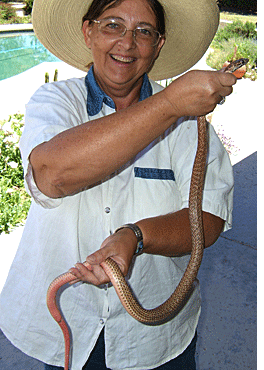
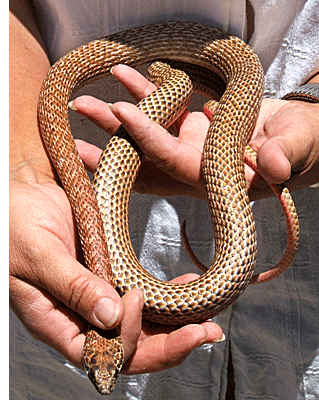 Coachwhips are non-poisonous Arizona snakes. They are always exciting to see simply because they are so unusually long, thin, and fast! The snake in this photo is "only" about five feet long, but some coachwhips exceed eight.
Coachwhips are non-poisonous Arizona snakes. They are always exciting to see simply because they are so unusually long, thin, and fast! The snake in this photo is "only" about five feet long, but some coachwhips exceed eight.This is a bright and gorgeous specimen of a Red Coachwhip -- you can see that in the desert sunlight it resembles a beautiful gold and copper braid (very Arizona!)
Coachwhips are skittish and flee with great speed. This one was discovered between our trash cans and the wall, so it didn't really have anyplace to run. These snakes eat lizards and rodents, and the occasional small bird or bat. They are partial to roadkill, and thus often become roadkill themselves.
You will occasionally see coachwhip tracks in loose sand. They resemble sidewinder tracks--however, sidewinders have much thicker bodies and are exceedingly rare in our region of Arizona.